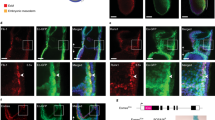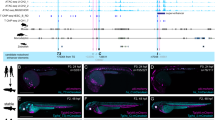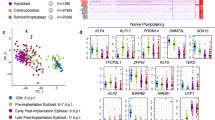Abstract
DEVELOPMENTAL genetics has shown that the Brachyury (T) gene has a key role in mesoderm formation during gastrulation in the mouse1,2. Homozygous embryos (Fig. 1) have a defective allantois, degenerate or absent notochord and disrupted primitive streak and node. The neural tube is kinked and somite formation interrupted3–6. The T gene has been cloned7 and is expressed during the early stages of gastrulation, being restricted to the primitive streak region, nascent mesoderm and notochord8. Neither the sequence of the gene nor its expression pattern define its developmental function7,9. To study the cell autonomy of the T mutation we have isolated and genetically characterized embryonic stem cell lines and studied their behaviour in chimaeras. T/+ embryonic stem cells form normal chimaeras, whereas T/T↔+/+ chimaeras mimic the T/T mutant phenotype. The results indicate that the T gene acts cell autonomously in the primitive streak and notochord but may activate a signalling pathway involved in the specification of other mesodermal tissues.
This is a preview of subscription content, access via your institution
Access options
Subscribe to this journal
Receive 51 print issues and online access
$199.00 per year
only $3.90 per issue
Buy this article
- Purchase on Springer Link
- Instant access to full article PDF
Prices may be subject to local taxes which are calculated during checkout
Similar content being viewed by others
References
Dobrovolskaia-Zavadskaia, N. C.R. Séanc. Soc. Biol. 97, 114–116 (1927).
Gluecksohn-Schonheimer, S. Proc. natn. Acad. Sci. U.S.A. 30, 134–140 (1944).
Chesley, P. J. exp. Zool. 70, 429–459 (1935).
Gruneberg, H. J. Embryol. exp. Morph. 6, 424–443 (1958).
Yanagisawa, K. O., Fujimoto, H. & Urushihara, H. Devl. Biol. 87, 242–248 (1981).
Fujimoto, H. & Yanagisawa, K. O. Differentiation 25, 44–47 (1983).
Herrmann, B. G., Labeit, S., Poustka, A., King, T. R. & Lehrach, H. Nature 343, 617–622 (1990).
Wilkinson, D., Bhatt, S. & Herrmann, B. G. Nature 343, 657–659 (1990).
Willison, K. Trends Genet. 6, 104–105 (1990).
Robertson, E. J. in Teratocarcinomas and Embryonic Stem Cells: A Practical Approach (ed. Robertson, E. J.) 71–112 (IRL, Oxford, 1987).
Bennett, D. Nature 272, 539 (1978).
Tam, P. P. L. & Beddington, R. S. P. Development 99, 109–126 (1987).
Lyon, M. F. J. Hered. 50, 140–142 (1959).
Searle, A. G. Genet. Res. 7, 86–95 (1966).
MacMurray, A. & Shin, H.-S. Genetics 120, 545–550 (1988).
Yanagisawa, K. O. Jap. J. hum. Genet. 65, 287–297 (1990).
Church, G. M. & Gilbert, W. Proc. natn. Acad. Sci. U.S.A. 81, 1991 (1984).
Herrmann, B. et al. Cell 44, 469–476 (1986).
Herrmann, B., Barlow, D. P. & Lehrach, H. Cell 48, 813–825 (1987).
Feinberg, A. P. & Vogelstein, B. Analyt. Biochem. 132, 6 (1983).
McLaren, A. & Buehr, M. Genet. Res. Camb. 37, 305–309 (1981).
Eicher, E. M. & Washburn, L. L. Proc. natn. Acad. Sci. U.S.A. 75, 946–950 (1978).
Author information
Authors and Affiliations
Rights and permissions
About this article
Cite this article
Rashbass, P., Cooke, L., Herrmann, B. et al. A cell autonomous function of Brachyury in T/T embryonic stem cell chimaeras. Nature 353, 348–351 (1991). https://doi.org/10.1038/353348a0
Received:
Accepted:
Issue Date:
DOI: https://doi.org/10.1038/353348a0
This article is cited by
-
Broad spectrum of CRISPR-induced edits in an embryonic lethal gene
Scientific Reports (2021)
-
Identification of a Novel Mouse Brachyury (T) Allele Causing a Short Tail Mutation in Mice
Cell Biochemistry and Biophysics (2010)
-
Maintenance of embryonic stem cell pluripotency by Nanog-mediated reversal of mesoderm specification
Nature Clinical Practice Cardiovascular Medicine (2006)
-
Unusual misregulation of RNA splicing caused by insertion of a transposable element into the T (Brachyury) locus
BMC Genomics (2003)
-
Placental development: Lessons from mouse mutants
Nature Reviews Genetics (2001)
Comments
By submitting a comment you agree to abide by our Terms and Community Guidelines. If you find something abusive or that does not comply with our terms or guidelines please flag it as inappropriate.



